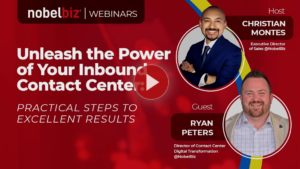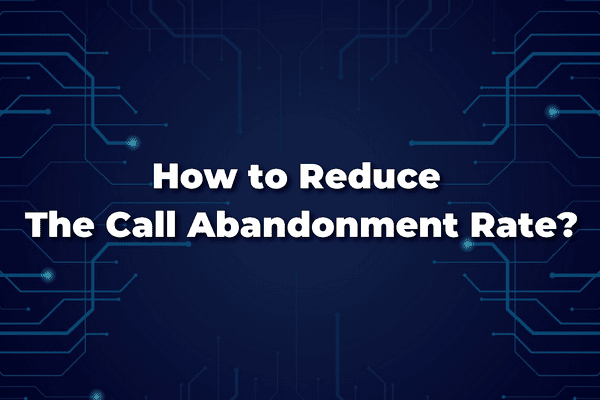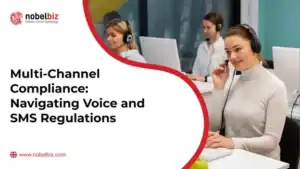The abandoned call rate represents the proportion of abandoned calls compared to the total number of calls made. In general, it should not be more than 5%. Beyond this acceptable level, a contact center must reconsider its strategy and resources in order to lower it as much as possible. Depending on the source of the call, your agents employ a variety of strategies to reduce call abandonment.
Call abandonment is a key performance indicator that may be used to evaluate the effectiveness of a contact center. The goal is to deliver the finest service possible to consumers. Observing this KPI enables you to detect and address your contact center’s dysfunctions.
It is also worth noting that call abandonment has a direct impact on customer satisfaction. Call waiting time is one metric that tends to define the quality of a customer’s experience and that of the service. It is therefore not unexpected that a high call abandonment rate and a poor client satisfaction rate coexist. Working on this indication is equivalent to acting on customer happiness, loyalty, and experience.
Furthermore, whether it is an existing client or a prospect, an abandoned call equals a missed business opportunity. Corrective steps are thus desirable in the event of a high call abandonment rate in order to minimize the impact on the company’s income. Here are 5 ways to optimize the call abandonment rate.
How to calculate the call abandonment rate for contact centers?
 Call Abandonment Rate expresses the proportion of incoming calls answered in a certain period out of the total number of calls. This is provided for the most basic cases (no overflow, callback ticket, etc.).
Call Abandonment Rate expresses the proportion of incoming calls answered in a certain period out of the total number of calls. This is provided for the most basic cases (no overflow, callback ticket, etc.).
Some call centers do not collect this information to evaluate service quality. Some contact centers also choose not to include immediate desertion, implying a misdialed number or other causes outside the call center agent’s control.
You should not consider a call abandoned until your agent teams have marked it as pending. In a self-service application, for example, abandoned calls should not be counted. Staff and queue abandonment rates should only reflect calls they could answer.
The basic formula for calculating the abandoned call rate is as follows:
Abandoned call rate = (Total calls – calls answered) / (Total calls) x 100
Is there an acceptable abandon rate for call centers?
Naturally, the abandoned call rate is given as a percentage. Many contact centers seek an abandoned call rate between 5% and 8%. This statistic may be used to evaluate the customer experience by comparing your services and assessing the relative efficacy of various customer care initiatives.
This, however, does not account for callers that called the incorrect number. It also does not account for clients who are stranded between hubs. Although these callers hung up, they did not end the conversation. Contact Centers should filter these calls out of the total abandonment rate.
As a result, a better formula for describing the desertion rate incorporates a filter. When someone quits up within 5 to 20 seconds, this one ignores the call. A caller’s goal is more likely to be represented by a shorter wait. Customers’ time may be wasted if there is a lengthier wait, especially when they discover that the projected wait time surpasses their patience.
Now let’s look at how you can optimize and reduce your call abandon rate.
1. Invest in contact center technologies
Consumers today are aware of their rights and will contact customer support if they are displeased. The best way to approach this is to direct callers to the right department. Fortunately, contact center software solutions such as call routing and automatic call distribution system (ACD) can easily handle this by linking callers to employees with the relevant competence. This minimizes waiting time and keeps consumers from being sent to the incorrect department.
On the other hand, if you see that most of your requests are identical, we propose implementing a CCaaS solution. Consequently, callers will obtain more information and be sent to the appropriate agents.
- Use an IVR: Inbound calls are qualified and directed to self-service or the appropriate service or adviser. Your consumers may respond to their most basic demands 24/7, in real-time, simply and straightforwardly, using this IVR, Interactive Voice Server. Partial automation enables you to deliver qualified and relevant information through self-service while focusing your agents on high-value-added calls.
- Provide a callback option: In times of peak demand, to prevent losing calls, providing a “callback” option to your customers may be crucial in maintaining a positive connection between customers and consultants. You may allow your clients to wait on the phone or be called back when a consultant becomes available. The consumer will spend less time waiting and will appreciate the procedure. To do this, you must create information sheets that include the client’s name, phone number, the purpose for the call, and the time the customer will be accessible.
- Regularly review your software: One cause of this “downtime” might be the poor speed of the software you use. Regularly checking the functionality of your software and servers can help you avoid losing time during a phone call. Create a comprehensive and up-to-date knowledge base, and update it regularly.
2. Use different communication channels for your clients
Did you know that According to PWC, 73% of all people around the world point to customer experience as an important factor in their purchasing decisions?
When clients have only one support option (for example, the phone), you will almost certainly receive more calls than your agents can manage. As a result, consumers will face long wait times, and your agents will be more vulnerable to stress and fatigue.
By implementing a multi-channel communication plan, you may lower the number of phone calls (and hence the abandonment rate) and relieve your agents of the high call volume. It will also offer your agents more time to handle and resolve each inquiry.
Customers like to interact with a brand through the following channels: social media, email, Messaging through text on WhatsApp or Telegram, and Live chat on the website. And the best way to do that is to integrate a CCaaS Solution that can provide your organization a true and authentic Omnichannel Experience for your agents and customers alike.
3. Encourage an active and responsive culture
 When an agent transfers a call, the service in issue must be responsive and able to satisfy the customer’s expectations in a timely manner. The consumer must not be placed on hold again throughout the transfer. This necessitates the internal propagation of customer culture and the sensitization of all teams. This is the heart of being a customer-centric contact center.
When an agent transfers a call, the service in issue must be responsive and able to satisfy the customer’s expectations in a timely manner. The consumer must not be placed on hold again throughout the transfer. This necessitates the internal propagation of customer culture and the sensitization of all teams. This is the heart of being a customer-centric contact center.
In addition to this organizational and cultural component, it is critical not to impose endless waiting times on that contact. The amount of time spent on the phone must be meticulously monitored. You must either decrease “dead air time” or make better use of it.
What exactly is “dead air time”? This word refers to intervals of quiet time between consumers and advisors on the phone. This “dead time” can be caused by several factors, including a lack of understanding on the adviser’s side, poor software, or even a challenging request. This results in a significant amount of waiting time, which is one of the most problematic aspects for most consumers who wish to contact a consultant.
Apply these common-sense strategies to prevent hurting the relationship between your consumers and your agents.
It is critical to properly train your agents since they may not answer a consumer because they lack expertise. Furthermore, if the consumer makes a particular request, the adviser must respond within one minute, or the waiting time would be significantly increased.
- Allow your agents to work independently: When a consumer phones an agent, they don’t want to hear, “I need to verify with my supervisor.” Your agents must be self-assured and capable of making judgments without the permission of their superiors. It might be aggravating to provide the client with “receptionists” agents.
- Prepare example scenarios: If your adviser has already prepared good statements for various situations, the time spent calming down an irritated customer or thanking them will be significantly reduced. With their training and pre-prepared formulae, your counselors will be able to deal with each client successfully and swiftly.
- Inform customers of what you are doing: If the client is kept informed of what the adviser is doing in real-time, he will be comforted that we are actively trying to solve his problem; this will also eliminate unwanted silence on the phone discussion. As a result, it is necessary to use the moment of quiet to build your relationship with your consumer by being involved.
- Use silence to discover more about your customers: If your consultant is in the middle of fixing an issue and there are moments of silence, they should use it to learn more about your consumer. This will help the organization enhance the relationship with its consumers and better target their expectations during future interactions.
- Manage the waiting time: The term “dead time” refers not only to the interaction between the client and the adviser but it may also refer to the time spent waiting on the phone. While the consumer waits for an adviser to respond, music or information will fill the silence, which might be aggravating. Even better: predicting the waiting time benefits the consumer, who can use this time to complete other chores.
- Look for abnormalities in a long phone conversation: Taking an interest in the most extended phone conversations will help you understand what’s causing them. By identifying the causes behind these lengthy conversations, you will provide ways to minimize this time significantly. You may accomplish this by using software that allows you to replay the most extended calls. This will help you assess your consultants’ effectiveness while better understanding why specific calls might go twice as long as others. Additional time management training will be available for consultants who have trouble eliminating “dead air time” in phone interactions.
Learn more about what Should Happen on the First Day of Call Center Training with Nancy Munro CEO & Founder Verbal Transactions. From our podcast serie “First Contact: Stories of the Call Center” find more on the basics of what should happen on the first day of call center training, including some often-overlooked things that typically need to be sorted out.
5. Improve your First-Call Resolution (FCR)
If there’s an ironclad rule about running a contact center, it’s that the number of KPIs (key performance indicators) you might want to track is limitless. Between Handling times, customer satisfaction, NPS, etc… Most contact centers don’t know where and how do you draw the line.
However, metrics begin to make more sense than others once you know what you’re attempting to achieve. Because any KPI that does not directly lead to improvement is immediately less valuable than those that do. In that regard, the Abandonment Rate is closely tied to your FCR or First Call Resolution.
The capacity to solve a customer’s issue on the first call is referred to as first-call resolution. If a caller’s issue is not solved on the first call, your call abandonment rate is likely to rise. Because individuals are more likely to become frustrated and hang up the phone if they call for the second or third time for the same problem. This, once again, might be ascribed to the agent’s expertise and ability to resolve consumer difficulties.

Learn more about Inbound Contact Center: Practical Steps to Excellent Results in our webinar episode. You will discover the best practices and optimization techniques for inbound campaigns, as well as new technologies that may significantly enhance inbound workflow and KPIs. And you will see how the emerging communication channels will play a more and more important role for inbound campaigns in contact centers.
Conclusion: If you abandon your calls, you abandon your clients

Call abandonment is a big issue and a pet peeve for every contact center, regardless of industry. It is an obvious sign that the consumer is dissatisfied with your company. Fortunately, if you follow these methods for reducing abandoned calls, you can significantly improve your customer experience and your contact center’s overall performance.
Nobelbiz has over 20 years of experience in the contact center sector and works with contact centers worldwide to help them attain their maximum productivity potential. We achieve this by offering the only telecom carrier and voice services built from the ground up to meet the demands of heavy call-center-specific traffic, paired with industry-leading omnichannel cloud contact center software and unique customer-centric support procedures that distinguish us as the industry’s promise keepers.
With NobelBiz, your contact center gets:
- The Lowest cents per min rates;
- The Highest contact rates and KPIs;
- A Seamless customer experience;
- A Dedicated support from our team of professionals.

Abdelmounim Benharouga has always had a strong passion for writing and digital marketing. He started as a Digital Content Writer part of marketing department then moved to being Customer Success Manager for the African Region within the Nobelbiz team.








